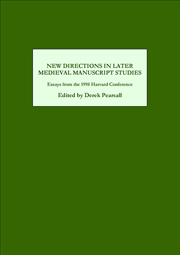Book contents
- Frontmatter
- Contents
- List of Illustrations
- Acknowledgements
- Introduction
- Recent Directions in Medieval Manuscript Study
- Another Fine Manuscript Mess: Authors, Editors and Readers of Piers Plowman
- A New Approach to the Witnesses and Text of the Canterbury Tales
- Prospecting in the Archives: Middle English Verse in Record Repositories
- Medieval Manuscripts and Electronic Media: Observations on Future Possibilities
- Representing the Middle English Manuscript
- Skins, Sheets and Quires
- Reconsidering the Auchinleck Manuscript
- Professional Readers of Langland at Home and Abroad: New Directions in the Political and Bureaucratic Codicology of Piers Plowman
- Professional Scribes? Identifying English Scribes Who Had a Hand in More Than One Manuscript
- Manuscript Production in Medieval Theatre: The German Carnival Plays
- The ‘Lancelot-Graal’ Project
- After Chaucer: Resituating Middle English Poetry in the Late Medieval and Early Modern Period
- Notes on Contributors
- Index
Representing the Middle English Manuscript
Published online by Cambridge University Press: 05 September 2014
- Frontmatter
- Contents
- List of Illustrations
- Acknowledgements
- Introduction
- Recent Directions in Medieval Manuscript Study
- Another Fine Manuscript Mess: Authors, Editors and Readers of Piers Plowman
- A New Approach to the Witnesses and Text of the Canterbury Tales
- Prospecting in the Archives: Middle English Verse in Record Repositories
- Medieval Manuscripts and Electronic Media: Observations on Future Possibilities
- Representing the Middle English Manuscript
- Skins, Sheets and Quires
- Reconsidering the Auchinleck Manuscript
- Professional Readers of Langland at Home and Abroad: New Directions in the Political and Bureaucratic Codicology of Piers Plowman
- Professional Scribes? Identifying English Scribes Who Had a Hand in More Than One Manuscript
- Manuscript Production in Medieval Theatre: The German Carnival Plays
- The ‘Lancelot-Graal’ Project
- After Chaucer: Resituating Middle English Poetry in the Late Medieval and Early Modern Period
- Notes on Contributors
- Index
Summary
The relationship between older texts and post-medieval strategies for representing them goes back to the beginnings of printing in England. The earliest printers reflected some awareness of the distinctiveness of their received materials. Caxton, for example, included a thorn sort in his fonts for printing Middle English. In the mid-sixteenth century John Day printed the first book using specially cut Anglo-Saxon types. But for about 250 years after the introduction of printing into England the standard form of representing Middle English was by black letter. A typographic form that was initially the norm for all printing became increasingly restricted to certain specific categories of texts after the introduction of roman and italic fonts to England in the early sixteenth century. All editions of Chaucer down to 1721, for instance, were printed in this way, and it was the conventional way of representing passages of Middle English in works printed in other types. This strategy obviously both signified the historical distance separating the original from the present and embodied it in what was increasingly from the early sixteenth century an ‘archaic’ form, one that offered a visual correlative to the lexical, dialectal and syntactical antiquity of the original.
Such signalling is itself a reflection of the increasing incomprehension in the post-medieval period about Middle English. Urry's 1721 Chaucer edition, the first printed in roman type, is, among other things, an acknowledgement that the distance of time had created the need for other strategies than black letter to represent what was, in effect, now an alien language.
- Type
- Chapter
- Information
- New Directions in Later Medieval Manuscript StudiesEssays from the 1998 Harvard Conference, pp. 65 - 80Publisher: Boydell & BrewerPrint publication year: 2000



